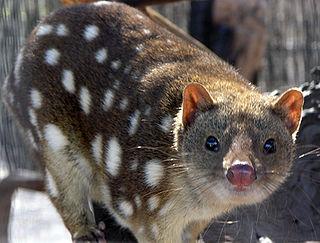Related Research Articles

Dasyuromorphia is an order comprising most of the Australian carnivorous marsupials, including quolls, dunnarts, the numbat, the Tasmanian devil, and the thylacine. In Australia, the exceptions include the omnivorous bandicoots and the marsupial moles. Numerous South American species of marsupials are also carnivorous, as were some extinct members of the order Diprotodontia, including extinct kangaroos and thylacoleonids, and some members of the partially extinct clade Metatheria and all members of the extinct superorder Sparassodonta.

The Dasyuridae are a family of marsupials native to Australia and New Guinea, including 69 extant species divided into 21 genera. Many are small and mouse-like or shrew-like, giving some of them the name marsupial mice or marsupial shrews, but the group also includes the cat-sized quolls, as well as the Tasmanian devil. They are found in a wide range of habitats, including grassland, underground, forests, and mountains, and some species are arboreal or semiaquatic. The Dasyuridae are often called the 'marsupial carnivores', as most members of the family are insectivores.

Threatened fauna of Australia are those species and subspecies of birds, fish, frogs, insects, mammals, molluscs, crustaceans and reptiles to be found in Australia that are in danger of becoming extinct. This list is the list proclaimed under the Australian federal Environment Protection and Biodiversity Conservation Act 1999. The classifications are based on those used by the World Conservation Union (IUCN), however IUCN and Australian rankings do differ. Each state and territory has its own legislation relating to environmental protection.
References
- ↑ Kemper, Catherine; Reardon, Terry; Queale, Lynette (2000). "Mammals". In Robinson, A. C.; Casperson, K. D.; Hutchinson, M. N. (eds.). A List of the Vertebrates of South Australia (PDF). Biological Survey of South Australia. Retrieved 9 December 2020.
- ↑ 'Extinct' wallaby goes back on show ABC News, 15 February 2012. Retrieved 8 December 2020.
- ↑ "Petaurus notatus". ASM Mammal Diversity Database. 1.5. American Society of Mammalogists . Retrieved 9 September 2021.
- ↑ Cremona, T., Baker, A. M., Cooper, S. J., Montague-Drake, R., Stobo-Wilson, A. M., & Carthew, S. M. (2020). Integrative taxonomic investigation of Petaurus breviceps (Marsupialia: Petauridae) reveals three distinct species. Zoological Journal of the Linnean Society.
- ↑ Jooste, James (28 June 2016). "Wild dog populations will be out of control within five years without dedicated dogger, former trapper says". ABC News . Retrieved 15 September 2021.
- ↑ Dulaney, Michael (22 July 2016). "'Every possible genetic combination': The diverse street dogs of the APY Lands". ABC News. Retrieved 15 September 2021.
- 1 2 Robinson, A. C.; Kemper, C. M.; Medlin, G. C.; Watts, C. H. S. (2000). "The rodents of South Australia". Wildlife Research. 27 (4): 379–404. doi:10.1071/WR97044.